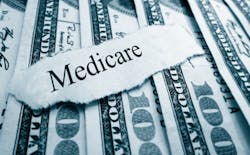Ninety-three percent of MIPS (Merit-based Incentive Payment System)-eligible clinicians received a positive payment adjustment for their performance in 2017, and 95 percent overall avoided a negative payment adjustment, according to a CMS (Centers for Medicare & Medicaid Services) announcement today.
The first year of MIPS under MACRA’s Quality Payment Program (QPP) was dubbed by CMS as a “pick your pace year,” which essentially enabled clinicians to avoid payment penalties as long as they submitted at least the minimum amount of quality data. As such, in its announcement, CMS did admit that the overall performance threshold for MIPS was established at a relatively low level of three points, and the availability of “pick your pace” provided participation flexibility through three reporting options for clinicians: “test”, partial year, or full-year reporting.
CMS said that 93 percent of MIPS-eligible clinicians received a positive payment adjustment for their performance in 2017, and 95 percent overall avoided a negative payment adjustment. CMS specifically calculated that approximately 1.06 million MIPS-eligible clinicians in total will receive a MIPS payment adjustment, either positive, neutral, or negative. The payment adjustments for the 2017 program year get reflected in 2019.
Breaking down the 93 percent of participants that received a positive payment adjustment last year, 71 percent earned a positive payment adjustment and an adjustment for exceptional performance, while 22 percent earned a positive payment adjustment only. Meanwhile, just 5 percent of MIPS-eligible clinicians received a negative payment adjustment, and 2 percent received a neutral adjustment (no increase or decrease).
Of the total population, just over one million MIPS-eligible clinicians reported data as either an individual, as a part of a group, or through an Alternative Payment Model (APM), and received a neutral payment adjustment or better. Additionally, under the Advanced APM track, just more than 99,000 eligible clinicians earned Qualifying APM Participant (QP) status, according to the CMS data.
CMS Administrator Seema Verma noted on the first pick-your-pace year of the QPP, “This measured approach allowed more clinicians to successfully participate, which led to many clinicians exceeding the performance threshold and a wider distribution of positive payment adjustments. We expect that the gradual increases in the performance thresholds in future program years will create an evolving distribution of payment adjustments for high performing clinicians who continue to invest in improving quality and outcomes for beneficiaries.”
For 2018, the second year of the QPP, CMS raised the stakes for those participating clinicians. And in the third year of the program, set to start in January 2019, a final rule was just published with year three requirements. Undoubtedly, as time passes, eligible clinicians will be asked for greater participation at higher levels. At the same time, CMS continues to exempt certain clinicians who don’t meet a low-volume Medicare threshold.
Earlier this year, CMS said that 91 percent of all MIPS-eligible clinicians participated in the first year of the QPP, exceeding the agency’s internal goal.
What’s more, from a scoring perspective in 2017, the overall national mean score for MIPS-eligible clinicians was 74.01 points, and the national median was 88.97 points, on a 0 to 100 scale. Further breaking down the mean and median:
- Clinicians participating in MIPS as individuals or groups (and not through an APM) received a mean score of 65.71 points and a median score of 83.04 points
- Clinicians participating in MIPS through an APM received a mean score of 87.64 points and a median score of 91.67 points
Additionally, clinicians in small and rural practices who were not in APMs and who chose to participate in MIPS also performed well, CMS noted. On average, MIPS eligible clinicians in rural practices earned a mean score of 63.08 points, while clinicians in small practices received a mean score of 43.46 points.
Said Verma, “While we understand that challenges remain for clinicians in small practices, these results suggest that these clinicians and those in rural practices can successfully participate in the program. With these mean scores, clinicians in small and rural practices would still receive a neutral or positive payment adjustment for the 2017, 2018, and 2019 performance years due to the relatively modest performance thresholds that we have established. We will also continue to directly support these clinicians now and in future years of the program.”


